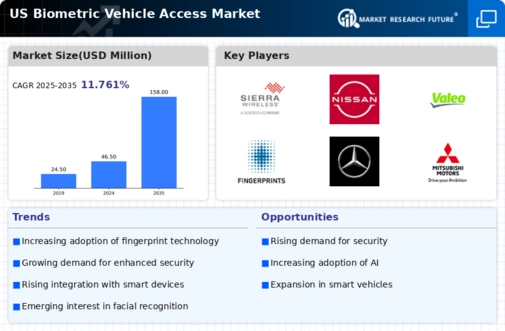Integration with Connected Vehicle Ecosystems
The integration of biometric vehicle-access systems with connected vehicle ecosystems is a key driver for the biometric vehicle-access market. As vehicles become increasingly connected through the Internet of Things (IoT), the demand for seamless and secure access methods is growing. Biometric systems can enhance the user experience by allowing drivers to unlock and start their vehicles using their unique biological traits, while also connecting to other smart devices. This integration not only improves convenience but also enhances security by ensuring that access is limited to authorized users. The convergence of biometric technology with connected vehicle systems is likely to propel the market forward, as consumers seek more integrated and user-friendly solutions.
Rising Demand for Enhanced Security Solutions
The biometric vehicle-access market is experiencing a notable surge in demand for enhanced security solutions. As vehicle theft rates continue to rise, consumers and manufacturers alike are increasingly prioritizing advanced security features. According to recent data, vehicle thefts in the US have escalated by approximately 10% over the past year, prompting a shift towards biometric systems that offer superior protection. These systems utilize unique biological traits, such as fingerprints or facial recognition, to ensure that only authorized users can access vehicles. This heightened focus on security is likely to drive innovation and investment in the biometric vehicle-access market, as stakeholders seek to develop more sophisticated and reliable solutions.
Technological Advancements in Biometric Systems
Technological advancements are playing a pivotal role in shaping the biometric vehicle-access market. Innovations in sensor technology, artificial intelligence, and machine learning are enhancing the accuracy and efficiency of biometric systems. For instance, the integration of high-resolution cameras and advanced algorithms allows for faster and more reliable facial recognition. As these technologies evolve, they are expected to reduce costs and improve user experience, making biometric systems more accessible to a broader audience. The market is projected to grow at a compound annual growth rate (CAGR) of around 15% over the next five years, driven by these technological improvements and the increasing adoption of smart vehicle features.
Regulatory Support for Advanced Security Technologies
Regulatory support for advanced security technologies is emerging as a significant driver in the biometric vehicle-access market. Government initiatives aimed at enhancing vehicle security standards are likely to promote the adoption of biometric systems. For example, recent legislation has mandated stricter security measures for new vehicles, which may include biometric access features. This regulatory environment encourages manufacturers to integrate biometric solutions into their offerings, thereby fostering market growth. As compliance with these regulations becomes essential, the biometric vehicle-access market is expected to benefit from increased investments and innovations aimed at meeting these new standards.
Consumer Awareness and Acceptance of Biometric Solutions
Consumer awareness and acceptance of biometric solutions are crucial drivers for the biometric vehicle-access market. As individuals become more informed about the benefits of biometric technology, including convenience and enhanced security, the demand for such systems is likely to increase. Surveys indicate that approximately 65% of consumers in the US express a willingness to adopt biometric vehicle access if it guarantees improved security and ease of use. This growing acceptance is encouraging manufacturers to invest in research and development, leading to the introduction of innovative biometric solutions tailored to consumer preferences. The market's expansion is thus closely tied to the evolving perceptions of biometric technology among potential users.
















Leave a Comment